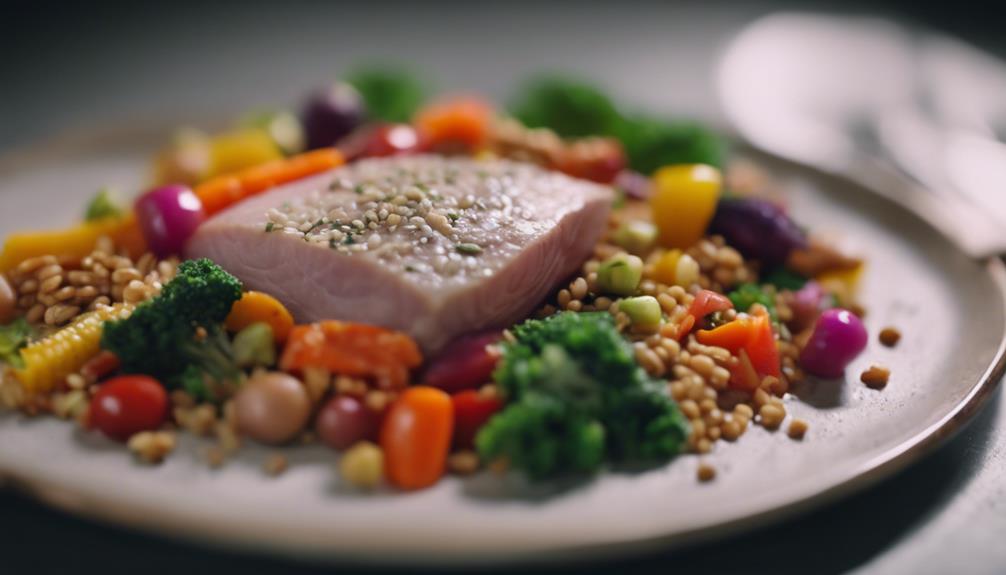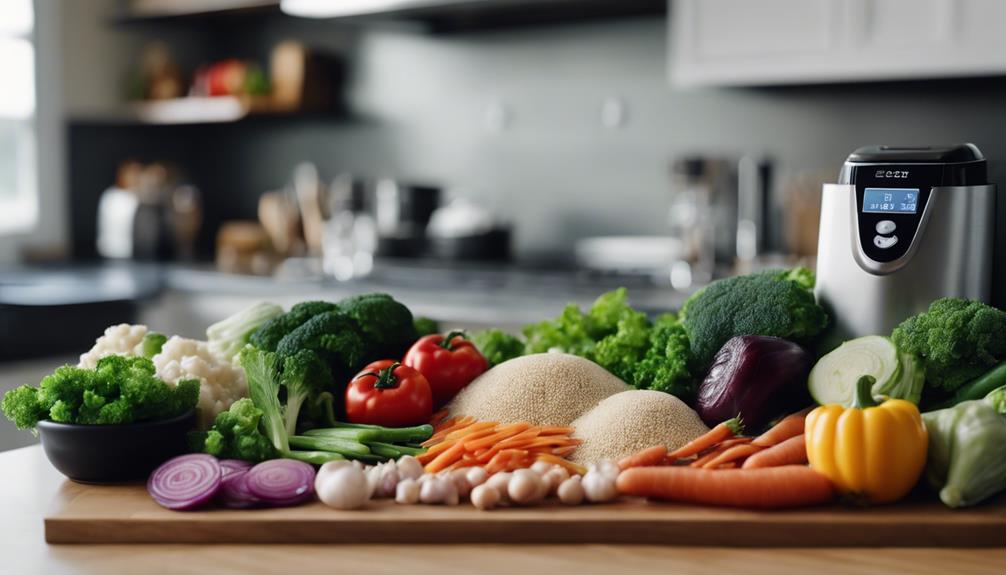Smart Carbs, Smart Cooking: Mastering the Montignac Diet With Sous Vide Techniques
Begin a journey to culinary mastery with the Montignac Diet and sous vide techniques. Choose low glycemic index foods to stabilize blood sugar and prioritize fiber-rich veggies for health. Separate carbs and fats to manage energy levels effectively and enhance weight control. Incorporate smart carbs like whole grains and lean proteins for stable energy. Utilize sous vide cooking to enhance flavors and embrace creativity in meal planning. Enjoy a balanced, nutrient-rich diet with smart carbs and innovative cooking methods. Learn more about mastering the Montignac Diet and sous vide for your culinary adventures.
What You Will Learn Here
- Utilize sous vide for precise cooking of lean proteins and vegetables.
- Incorporate fiber-rich smart carbs like quinoa and whole grains.
- Enhance flavors with herbs and spices for nutrient-dense meals.
- Plan ahead for efficient meal prep and adherence to the Montignac Diet.
- Embrace creativity in cooking to enjoy a variety of balanced, low GI dishes.
Understanding the Montignac Diet

Understanding the Montignac Diet involves prioritizing low glycemic index (GI) foods to effectively manage weight and promote overall health. Low GI foods are digested more slowly, leading to gradual rises in blood sugar levels and increased feelings of fullness. This approach can aid in weight management and reduce the risk of chronic diseases like diabetes and heart conditions.
Fiber, a key component of the Montignac Diet, plays an essential role in regulating blood sugar levels and promoting satiety. Vegetables, rich in fiber and essential nutrients, are highly recommended for their low GI content. Incorporating a variety of colorful vegetables into your meals not only boosts fiber intake but also provides antioxidants that support overall health.
Mindful eating is another cornerstone of the Montignac Diet. By paying attention to hunger cues, savoring each bite, and eating slowly, you can enhance your awareness of portion sizes and prevent overeating. This practice fosters a healthier relationship with food and encourages more intentional food choices.
Combining Sous Vide with Montignac Diet
Combining Sous Vide techniques with the Montignac Diet enhances the precision and nutritional value of your meals. The Montignac Diet emphasizes selecting foods with a lower glycemic index (GI) to effectively manage weight and blood sugar levels. By incorporating Sous Vide cooking methods, you can prepare perfectly cooked, healthy dishes that align with the principles of this diet. Sous Vide cooking provides precise temperature control, essential for maintaining the nutritional integrity of Montignac-approved ingredients. This cooking technique also enhances the flavors of Montignac-friendly foods while retaining their health benefits.
When using Sous Vide with the Montignac Diet, consider incorporating olive oil for added flavor and health benefits. The controlled and gentle cooking process of Sous Vide complements the Montignac Diet's focus on wholesome ingredients and smart cooking methods. This combination ensures that your meals aren't only delicious but also nutritionally balanced. By leveraging Sous Vide technology, you can achieve excellent results in meal preparation while adhering to the Montignac Diet's guidelines. Experimenting with Sous Vide and Montignac-approved ingredients will elevate your culinary experience and support your overall well-being.
Science Behind the Montignac Method
Delving into the scientific underpinnings of the Montignac Method reveals a dietary approach intricately tied to the glycemic index concept, which scrutinizes how different foods influence blood sugar levels. This method focuses on optimizing carbohydrate choices to promote stable blood sugar levels and overall well-being.
Here are some key points to ponder when exploring the science behind the Montignac Method:
- Impact of GI: Understanding the glycemic index helps in differentiating between high and low GI foods, which can affect blood sugar levels differently.
- Blood Sugar Control: By choosing low GI foods, you can regulate blood sugar levels more effectively, leading to sustained energy and potential weight loss.
- Carbohydrate-Fat Separation: The Montignac Method highlights the importance of separating carbohydrates and fats in meals to enhance blood sugar control.
- Health Benefits: Incorporating fiber-rich foods such as vegetables, lean protein, fruits, and whole grains can contribute to improved health outcomes.
- Overall Well-being: Following the Montignac Method can't only aid in weight management but also reduce health risks and promote a balanced lifestyle.
Understanding the science behind the Montignac Method empowers you to make informed dietary choices that can positively impact your health and well-being. By leveraging this knowledge, you can optimize your nutrition to support a healthier lifestyle.
Principles of the Montignac Diet
To effectively follow the Montignac Diet, prioritize selecting low glycemic index (GI) foods to support weight management and overall health improvement. The key principle of this diet is to focus on foods that have a lower impact on blood sugar levels, which can help in controlling weight and promoting better health. By emphasizing low GI foods, such as vegetables, lean protein, fruits, and whole grains, you can optimize your diet to enhance weight loss and overall well-being without the need for calorie counting.
Another important aspect of the Montignac Diet is the separation of carbohydrates and fats in meals. This practice aims to regulate blood sugar levels and improve digestion by preventing the simultaneous intake of high levels of both macronutrients. By structuring your meals to include carbohydrates and fats separately, you can better manage your energy levels and enhance the efficiency of your body's metabolic processes.
Additionally, the Montignac Diet underscores the significance of fiber in controlling hunger and stabilizing glucose release. Including fiber-rich foods in your meals can help you feel full for longer periods and avoid sudden spikes in blood sugar levels. By adhering to the principles of the Montignac Diet and making smart food choices, you can experience positive changes in weight management, insulin sensitivity, and overall health.
Glycemic Index Importance

Understanding the importance of the glycemic index (GI) in your diet can greatly impact your blood sugar levels and overall health. The GI measures how quickly carbohydrates in food raise blood sugar levels after consumption. Here are five key points to take into account regarding the glycemic index:
- Foods with a high GI are digested rapidly, leading to quick spikes in blood sugar, while low GI foods are digested slowly for sustained energy.
- Following a low GI diet, like the Montignac Diet, can help stabilize blood sugar levels, reduce cravings, and aid in weight management.
- High GI foods are often processed and refined carbohydrates, while low GI foods include whole grains, vegetables, fruits, and lean proteins.
- Incorporating low GI foods into your meals can help you feel fuller for longer periods and maintain a more stable energy level throughout the day.
- Understanding the GI of foods is essential in the Montignac Diet to make informed choices for better health and balanced blood sugar levels.
Carbs and Fats Separation
Steering clear of combining high glycemic index carbohydrates with fats lies at the heart of the Montignac Diet's principle of separating carbs and fats to stabilize blood sugar levels and support overall well-being. By following this approach, you can effectively manage blood sugar spikes and promote a healthier lifestyle. When high GI carbs are paired with fats in a meal, they can lead to rapid increases in blood sugar levels, followed by a crash, leaving you feeling tired and hungry shortly after eating. This separation strategy aims to regulate insulin response, prevent energy fluctuations, and maintain consistent energy levels throughout the day.
Adhering to the Montignac Diet's principle of separating carbs and fats encourages the consumption of whole, natural foods over processed alternatives. This shift towards nutrient-dense options can optimize your overall nutrient intake and enhance metabolic function. By understanding the impact of carb and fat separation on your body, you can make informed choices when planning your meals, leading to increased satiety and improved weight management outcomes. Embracing this concept can revolutionize the way you approach food, empowering you to take control of your health and well-being through mindful eating practices.
Role of Fiber in the Diet

Fiber plays a significant role in maintaining stable blood sugar levels and promoting satiety in the Montignac Diet. Incorporating fiber-rich foods into your meals can have a profound impact on your overall health and well-being.
Here are five key points highlighting the importance of fiber in your diet:
- Control Blood Sugar: Soluble fiber, found in foods like oats, fruits, and legumes, slows down digestion, helping to better manage blood sugar levels.
- Promote Satiety: Fiber-rich foods help you feel full and satisfied for longer periods, reducing the temptation to overeat or snack on unhealthy options.
- Aid Digestive Health: Insoluble fiber, abundant in vegetables and whole grains, adds bulk to stools and supports healthy digestion.
- Prevent Blood Sugar Spikes: High-fiber foods can prevent sudden spikes in blood sugar levels, providing a more stable source of energy throughout the day.
- Support Weight Management: Including a variety of fiber-rich foods in your diet can contribute to long-term weight management goals by promoting feelings of fullness and reducing overall calorie intake.
Foods to Eat and Avoid
To maintain stable blood sugar levels and promote weight loss on the Montignac Diet, focus on consuming low glycemic index (GI) foods like vegetables, lean proteins, fruits, and whole grains while limiting or avoiding high GI foods such as refined carbohydrates and processed foods. Low GI foods release glucose into the bloodstream slowly, preventing spikes in blood sugar levels and promoting satiety, which can aid in weight management. Vegetables like leafy greens, broccoli, and bell peppers are excellent choices due to their high fiber content and low impact on blood sugar.
Lean proteins such as chicken, turkey, fish, and tofu aren't only beneficial for muscle maintenance but also help keep you feeling full for longer periods. Fruits like berries, apples, and citrus fruits offer a sweet treat without causing rapid blood sugar fluctuations. Whole grains such as quinoa, barley, and oats are rich in fiber, vitamins, and minerals, making them a smart choice for sustained energy levels.
On the other hand, high GI foods like white bread, sugary snacks, and sugary beverages should be limited or avoided as they can lead to rapid spikes and crashes in blood sugar levels. Processed foods often contain added sugars and refined carbohydrates, making them less suitable for maintaining stable blood sugar. By being mindful of your food choices and opting for smart carbs, you can optimize your diet on the Montignac plan and support your overall health goals.
Benefits of the Montignac Diet

Emphasizing the consumption of low glycemic index (GI) foods, the Montignac Diet offers a structured approach to improving weight management and overall health. By following the principles of this diet, you can experience a range of benefits that contribute to your well-being:
- Weight Management: The Montignac Diet helps in weight loss by focusing on low GI foods that keep you feeling full and satisfied for longer periods.
- Blood Sugar Control: Separating carbohydrates and fats in meals as recommended by this diet can aid in better blood sugar regulation, reducing spikes and crashes.
- Nutrient-Rich Choices: By including fiber-rich foods like vegetables, lean protein, fruits, and whole grains, you ensure your body receives essential nutrients for optimal functioning.
- Improved Cholesterol Levels: Following the Montignac Diet can lead to improvements in cholesterol levels, reducing the risk of heart disease and related complications.
- Enhanced Insulin Sensitivity: Individuals with type 2 diabetes may benefit from this diet as it has been associated with enhanced insulin sensitivity, potentially aiding in better blood sugar management.
These benefits highlight how the Montignac Diet offers a holistic approach to health, focusing on both weight management and overall well-being through smart food choices and meal structuring.
Sample Meal Plan
To create a balanced and satisfying meal plan following the Montignac Diet with Sous Vide techniques, thoughtful selection of nutrient-rich ingredients is key. A sample meal plan could encompass a breakfast of Greek yogurt with berries, a lunch featuring grilled chicken alongside steamed vegetables, and a dinner comprising salmon paired with quinoa and roasted asparagus. This meal plan emphasizes the importance of incorporating lean proteins, healthy fats, and complex carbohydrates to help stabilize blood sugar levels and support weight management goals. For snacks, consider options like nuts, seeds, or vegetable sticks with hummus to maintain energy levels throughout the day.
Enhancing the flavor of these meals can be achieved through the use of fresh herbs and spices, adding depth without the need for excessive calories or unhealthy ingredients. Planning ahead and prepping ingredients in advance can facilitate adherence to the Montignac Diet with Sous Vide techniques, making it easier to sustain a healthy eating routine. By focusing on nutrient-dense foods and utilizing innovative cooking methods like sous vide, you can elevate your culinary experience while promoting overall well-being. Embrace the creativity and versatility that this meal plan offers, and enjoy the benefits of nourishing your body with smart carbs and smart cooking techniques.
Frequently Asked Questions
Is Sous Vide Cooking Good or Bad?
Sous vide cooking is good for various reasons. It offers precise control over cooking temperatures, ideal for preparing low GI foods. This gentle method helps retain nutrients in ingredients, making it a top choice for health-conscious individuals.
You'll find it great for cooking lean proteins and veggies without added fats. By sealing food in a water bath, sous vide maintains flavors and textures, enhancing your dining experience. It guarantees perfectly cooked, flavorful meals in line with smart carb choices.
What's the Big Deal About Sous Vide?
Sous vide cooking offers precision and consistency by maintaining exact temperatures, resulting in perfectly cooked meals. This method preserves flavors, juices, and nutrients, ensuring a delicious and nutritious outcome.
With sous vide, you can avoid the pitfalls of overcooking or undercooking, making it a reliable technique for meal prep. It allows for easy finishing touches like a quick sear to enhance taste and presentation.
This innovative approach revolutionizes the way you cook your meals.
Is Sous Vide Safe Plastic?
Yes, Sous Vide is safe with food-grade plastic bags specifically designed for cooking, like polyethylene or polypropylene. Avoid using regular plastic bags or containers not meant for high-temperature cooking.
Opt for BPA-free plastic bags to reduce health risks from Bisphenol A. Some prefer silicone or reusable vacuum-sealed bags for eco-friendly choices.
Always adhere to manufacturer guidelines for plastic bag use with Sous Vide for safety and best outcomes.
What Is the Sous Vide Method of Preparing Meals?
Sous vide cooking involves sealing food in a bag and cooking it in a water bath at a precise temperature. This method guarantees even cooking, retains natural flavors, and nutrients.
With sous vide, you have control over the doneness of the food for perfectly cooked dishes. It's great for tough meats, infusing flavors, and consistent results.
Busy people love it for preparing healthy meals with minimal effort and maximum flavor.
Conclusion
To sum up, mastering the Montignac Diet with sous vide techniques offers a practical and innovative approach to healthy eating. By understanding the science behind smart carbs and the principles of this diet, you can create delicious and nutritious meals that nourish your body and satisfy your taste buds.
With the benefits of sous vide cooking and the Montignac method, you can transform your culinary experience and embrace a healthier lifestyle. Start your journey towards improved well-being today!










